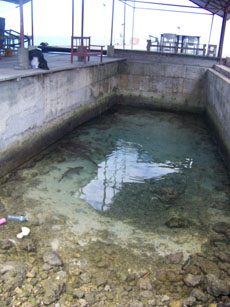The Environmental Protection Authority (EPA) has labelled local business tycoon Mohamed ‘Champa’ Moosa an “environmental criminal” for irreversibly damaging the island of Thun’bafushi and the marine ecosystem of Thun’bafalhu.
The EPA on Thursday fined Moosa the maximum penalty of Rf100 million (US$6.5 million) for conducting dredging and reclamation works in the area without an Environmental Impact Assessment (EIA).
Director-General of the EPA Mohamed Zuhair has reportedly resigned over the matter. Furthermore, Police Sub-Inspector Ahmed Shiyam confirmed to Minivan News that Zuhair had been taken in for questioning regarding an undisclosed investigation. Zuhair was not responding at time of press.
Director of the EPA Ibrahim Naeem told Minivan News the area had been irreversibly damaged and a large reef habitat destroyed.

“This was originally a reef ecosystem with a small sand bank in the middle, but he has been dredging the island without any clearance and the changes are now irreversible,” Naeem said.
After three surveys of the area, the EPA had assessed the damage as amounting to Rf2,230,293,566 (US$144.6 million), not including the impact of sedimentation from the dredging which can smother coral kilometres from the site.
A foreign consultant who was involved in surveying the island told Minivan News that the area “seems to have been used as a dumping ground.”
“There were what looked like hundreds of used car batteries, waste metals and oil drums leeching into the marine environment,” the consultant said.
“We were looking at the effect of the dredging on sedimentation, and there were no water quality tests done. But you can just imagine what it would have been like with all the batteries and waste metals.”
Images of the island obtained by Minivan News showed discarded piles of rubbish and batteries, old earthmoving machinery rusting in the sun, and half a dozen reef sharks in a tank containing a foot of tepid water.
While the unauthorised reclamation works are several years old and have been a subject of EPA concern for some time, Naeem explained that the procedure and mechanism for calculating and issuing fines was only established in February this year.
The Environmental Protection Act already states the requirement for an EIA assessment and the illegality of conducting works without acquiring one, but does not outline how this should be penalised. Naeem noted that the EPA had lost court battles on the specifics prior to the introduction of the new framework in February.
“We now calculate environmental damage caused by [unauthorised] dredging at Rf65,000 (US$4200) per square metre,” Naeem said, “but Rf100,000 million is the maximum fine.”
Fines were open to appeal and negotiation, Naeem said, suggesting that “this is likely to happen in this case.”

Moosa could also request the EPA resurvey the damaged area, Naeem said, although he noted that the EPA had already surveyed the area three times, most recently in March.
Ali Rilwan of Environmental NGO Bluepeace expressed concern that the EPA’s previous issuing of fines for environmental damage was sporadic, and those that were issued were often unpaid “or the day afterwards, pardon is given.”
The EPA’s lack of independence from the executive also “raised doubts” as to whether fines were politically motivated – Moosa’s business interests include private broadcaster DhiTV, which the ruling Maldivian Democratic Party (MDP) has previously criticised for being heavily aligned to the opposition.
“The Environmental Act does not conflict with the Constitution, but the EPA should be an independent body like the Human Rights Commission,” Rilwan said.
“It should be an independent agency autonomous from the government staffed by academic professionals, rather than civil servants and ministers. Because of the current setup, we do have doubts [over its independence].”

Naeem responded that while he did not know if there was a political element to the decision to fine Moosa a week before the government was seeking to push through major economic reforms in parliament, “what we do know is that Champa has definitely done this without a license or any form of clearance.”
“I don’t know if there is a political element – but he has committed a crime, and we have to take our responsibility towards the environment seriously,” he said.
Minivan News contacted Champa Moosa for comment but he had not responded at time of press.